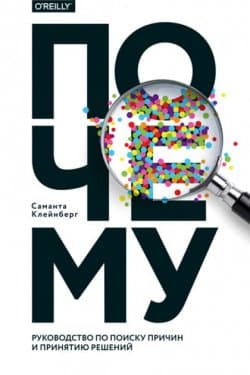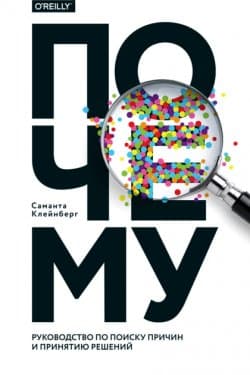Почему - Саманта Клейнберг (2017)
-
Год:2017
-
Название:Почему
-
Автор:
-
Жанр:
-
Язык:Русский
-
Страниц:160
-
Рейтинг:
-
Ваша оценка:
Автор показывает, что такое причинно-следственная связь, поясняет, почему в ее определении мы часто ошибаемся, как можно принимать верные решения. Благодаря этой книге вы научитесь анализировать информацию, выявлять причинно-следственные связи, объединять прошлое, предсказывать будущее.
Книга будет интересна философам, аналитикам, экономистам, медикам, юристам, начинающим ученым.
Почему - Саманта Клейнберг читать онлайн бесплатно полную версию книги
Hajjar, E. R., Cafiero, A. C., and Hanlon, J. T. (2007). Polypharmacy in elderly patients. The American Journal of Geriatric Pharmacotherapy, 5(4): 345–351.
Halpern, J. Y. and Hitchcock, C. R. (2010). Actual Causation and the Art of Modeling. In R. Dechter, H. Geffner, and J. Y. Halpern (eds.), Heuristics, Probability and Causality: A Tribute to Judea Pearl, pp. 383–406. College Publications, London.
Hanushek, E. A. (2011). The economic value of higher teacher quality. Economics of Education Review, 30(3): 466–479.
Hart, H. L. A. and Honoré, T. (1985). Causation in the Law. Oxford University Press, Oxford.
Haskins, R. and Sawhill, I. V. (2009). Creating an Opportunity Society. Brookings Institution Press, Washington, DC.
Hastie, R. and Pennington, N. (1996). The O. J. Simpson Stories: Behavioral Scientists’ Reflections on The People of the State of California v. Orenthal James Simpson. University of Colorado Law Review, 67: 957–976.
Haushofer, J. and Shapiro, J. (2013). Household response to income changes: Evidence from an unconditional cash transfer program in Kenya. Technical report.
Hausman, D. M. (2005). Causal Relata: Tokens, Types, or Variables? Erkenntnis, 63(1): 33–54.
Heeger, D. J. and Ress, D. (2002). What does fMRI tell us about neuronal activity? Nature Reviews Neuroscience, 3(2): 142–151.
Heider, F. and Simmel, M. (1944). An Experimental Study of Apparent Behavior. The American Journal of Psychology, 57(2): 243–259.
Henning, A. S. (1948). Dewey defeats Truman. Chicago Tribune, November: p. 1.
Henrich, J., Heine, S. J., and Norenzayan, A. (2010). The weirdest people in the world? Behavioral and Brain Sciences, 33(2–3): 61–83.
Heres, S., Davis, J., Maino, K., Jetzinger, E., Kissling, W., and Leucht, S. (2006). Why Olanzapine Beats Risperidone, Risperidone Beats Quetiapine, and Quetia-pine Beats Olanzapine: An Exploratory Analysis of Head-to-Head Comparison Studies of Second-Generation Antipsychotics. American Journal of Psychiatry, 163(2): 185–194.
Hernan, M. A., Clayton, D., and Keiding, N. (2011). The Simpson’s paradox unraveled. International Journal of Epidemiology, 40(3): 780–785.
Herndon, T., Ash, M., and Pollin, R. (2014). Does high public debt consistently stifle economic growth? A critique of Reinhart and Rogoff. Cambridge Journal of Economics, 38(2): 257–279.
Hill, A. B. (1965). The Environment and Disease: Association or Causation? Proceedings of the Royal Society of Medicine, 58(5): 295–300.
Hitchcock, C. and Knobe, J. (2009). Cause and norm. Journal of Philosophy, 106(11): 587–612.
Hitchcock, C. R. (1995). The Mishap at Reichenbach Fall: Singular vs. General Causation. Philosophical Studies, 78(3): 257–291.
Ho, Y. C. and Pepyne, D. L. (2002). Simple Explanation of the No-Free-Lunch Theorem and Its Implications. Journal of Optimization Theory and Applications, 115(3): 549–570.
Höfer, T., Przyrembel, H., and Verleger, S. (2004). New evidence for the Theory of the Stork. Paediatric and Perinatal Epidemiology, 18(1): 88–92.
Höfler, M. (2005). The Bradford Hill considerations on causality: A counterfactual perspective. Emerging Themes in Epidemiology, 2: 11.
Holgate, S. T., Komaroff, A. L., Mangan, D., and Wessely, S. (2011). Chronic fatigue syndrome: Understanding a complex illness. Nature Reviews Neuroscience, 12(9): 539–544.
Holson, L. M. (2009). Putting a Bolder Face on Google. The New York Times, February: p. B1.
Holyoak, K. J. and Cheng, P. W. (2011). Causal Learning and Inference as a Rational Process: The New Synthesis. Annual Review of Psychology, 62: 135–163.
Howick, J. (2011). Placebo Controls: Problematic and Misleading Baseline Measures of Effectiveness, pp. 80–95. Wiley-Blackwell, Chichester, West Sussex, UK.
 Почему они не работают? Новый взгляд на мотивацию сотрудников Сьюзен Фаулер
Почему они не работают? Новый взгляд на мотивацию сотрудников Сьюзен Фаулер
 Королевство Аманда Стивенс
Королевство Аманда Стивенс
 Почему Саманта Клейнберг
Почему Саманта Клейнберг
 Момент истины. Почему мы ошибаемся, когда все поставлено на карту, и что с этим делать? Сайен Бейлок
Момент истины. Почему мы ошибаемся, когда все поставлено на карту, и что с этим делать? Сайен Бейлок
 Почему. Руководство по поиску причин и принятию решений Саманта Клейнберг
Почему. Руководство по поиску причин и принятию решений Саманта Клейнберг
 Здравый смысл врет. Почему не надо слушать свой внутренний голос Уоттс Дункан
Здравый смысл врет. Почему не надо слушать свой внутренний голос Уоттс Дункан

 Пир теней
Пир теней  Князь во все времена
Князь во все времена  Когда порвется нить
Когда порвется нить  Пока я здесь
Пока я здесь 



